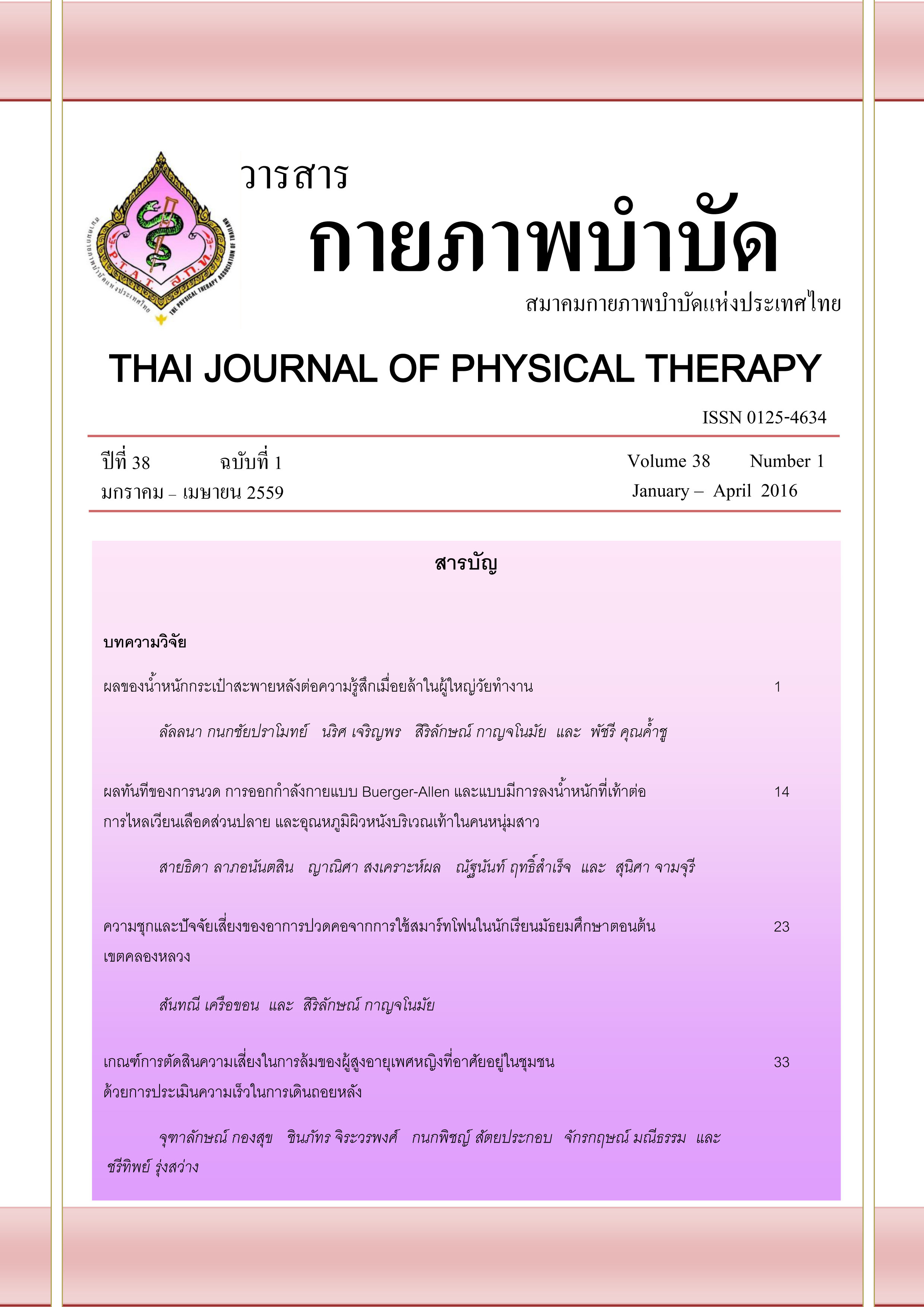การหาเกณฑ์ความเร็วที่ใช้ในการตัดสินเพื่อประเมินความเสี่ยงในการล้ม ขณะเดินถอยหลังของผู้สูงอายุเพศหญิงที่อาศัยอยู่ในชุมชน
Main Article Content
บทคัดย่อ
การศึกษาครั้งนี้มีวัตถุประสงค์หลักเพื่อเปรียบเทียบความเร็วในการเดินถอยหลังระหว่างเพศหญิงช่วงอายุต่างๆ รวมทั้งระหว่างผู้สูงอายุเพศหญิงที่มีและไม่มีประวัติการล้ม ที่อาศัยอยู่ในชุมชนทั่วไป อำเภอเมือง จังหวัดพิษณุโลก และหาเกณฑ์ความเร็วที่ใช้ทำนายโอกาสเสี่ยงในการล้ม ผู้เข้าร่วมการวิจัย คือ วัยรุ่นเพศหญิง (อายุ 20-25 ปี) วัยกลางคนเพศหญิง (อายุ 35-50 ปี) ผู้สูงอายุเพศหญิงที่มีและไม่มีประวัติการล้ม ภายใน 6 เดือน (อายุ 60-79 ปี) จำนวนกลุ่มละ 10 คน ทำการศึกษาเปรียบเทียบความเร็วขณะเดินก้าวถอยหลังระหว่างอาสาสมัครในแต่ละกลุ่ม โดยใช้สถิติ One Way ANOVA (Tukey เป็น post hoc) เปรียบเทียบความเร็วระหว่างผู้สูงอายุที่มีและไม่มีประวัติการล้มโดยใช้สถิติ Independent Sample T test และหาค่าเกณฑ์ความเร็วโดยใช้วิธีการหาค่า Receiver Operating Characteristic (ROC) โดยกำหนดค่าระดับนัยสำคัญทางสถิติ p<0.05
ผลการศึกษาพบความแตกต่างกันอย่างมีนัยสำคัญทางสถิติระหว่างเพศหญิงในช่วงอายุต่างๆ(p<0.05) ซึ่งผู้สูงอายุมีความเร็วในการเดินถอยหลังช้ากว่าวัยรุ่น และวัยกลางคน (p=0.033) และในผู้สูงอายุเพศหญิงที่มีประวัติการล้มมีความเร็วในการทดสอบช้ากว่าผู้สูงอายุเพศหญิงที่ไม่มีประวัติการล้ม (p=0.003) สำหรับค่าเกณฑ์ความเร็วที่ใช้ในการทำนายโอกาสเสี่ยงต่อการล้มของการทดสอบเดินถอยหลัง คือ น้อยกว่าหรือเท่ากับ 0.29 เมตรต่อวินาที (Sensitivity = 1.00, Specificity = 1.00, Overall = 1.00) ซึ่งสามารถนำไปใช้ประเมินความเสี่ยงในการล้มสำหรับผู้สูงอายุเพศหญิงที่อาศัยอยู่ในชุมชนได้
Article Details
เอกสารอ้างอิง
2. O'Sullivan M, Blake C, Cunningham C, Boyle G, Finucane C. Correlation of accelerometry with clinical balance tests in older fallers and non-fallers. Age Ageing. 2009;38(3):308-13.
3. Whitney SL, Poole JL, Cass SP. A review of balance instruments for older adults. Am J Occup Ther. 1998;52(8):666-71.
4. Callisaya ML, Blizzard L, McGinley JL, Srikanth VK. Risk of falls in older people during fast-walking--the TASCOG study. Gait Posture. 2012;36(3):510-5.
5. Chen TY, Peronto CL, Edwards JD. Cognitive function as a prospective predictor of falls. J Gerontol B Psychol Sci Soc Sci. 2012;67(6):720-8.
6. Manckoundia P, Mourey F, Pfitzenmeyer P, Van Hoecke J, Perennou D. Is backward disequilibrium in the elderly caused by an abnormal perception of verticality? A pilot study. Clin Neurophysiol. 2007;118(4):786-93.
7. Hausdorff JM, Nelson ME, Kaliton D, Layne JE, Bernstein MJ, Nuernberger A, et al. Etiology and modification of gait instability in older adults: a randomized controlled trial of exercise. J Appl Physiol (1985). 2001;90(6):2117-29.
8. Takeuchi Y, Tanaka Y, Shimomura Y, Iwanaga K, Katsuura T. The effect of aging on the backward stepping reaction as estimated from the velocity of center of foot pressure and muscular strength. J Physiol Anthropol. 2007;26(2):185-9.
9. Espy DD, Yang F, Bhatt T, Pai YC. Independent influence of gait speed and step length on stability and fall risk. Gait Posture. 2010;32(3):378-82.
10. Galica AM, Kang HG, Priplata AA, D'Andrea SE, Starobinets OV, Sorond FA, et al. Subsensory vibrations to the feet reduce gait variability in elderly fallers. Gait Posture. 2009;30(3):383-7.
11. DeGoede KM, Ashton-Miller JA. Biomechanical simulations of forward fall arrests: effects of upper extremity arrest strategy, gender and aging-related declines in muscle strength. J Biomech. 2003;36(3):413-20.
12. Kim KJ, Ashton-Miller JA. Segmental dynamics of forward fall arrests: a system identification approach. Clin Biomech (Bristol, Avon). 2009;24(4):348-54.
13. Fritz NE, Worstell AM, Kloos AD, Siles AB, White SE, Kegelmeyer DA. Backward walking measures are sensitive to age-related changes in mobility and balance. Gait Posture. 2013;37(4):593-7.
14. Soda N, Ueki T, Aoki T. Three-dimensional Motion Analysis of the Ankle during Backward Walking. J Phys Ther Sci. 2013;25(6):747-9.
15. Train The Brain Forum Committee. Thai Mental State Examination (TMSE). Siriraj Hosp Gaz. 1993;45:259-74.
16. Bellamy N. Osteoarthritis—an evaluative index for clinical trials [MSc thesis]. Canada: McMaster University,Hamilton, Ontario; 1982.
17. Kuptniratsaikul V, Rattanachaiyanont M. Validation of a Modified Thai version of the
Western Ontario and McMaster (WOMAC) Osteoarthritis Index for Knee Osteoarthritis. Clin Rheumatol 2007;26:1641-5.
18. Podsiadlo D, Richardson S. The timed "Up & Go": a test of basic functional mobility for frail elderly persons. J Am Geriatr Soc. 1991;39(2):142-8.
19. Borg G. Psychophysical Bases of Perceived Exertion. Med Sci Sports Exerc. 1982;14(5):377-81.
20. Portney LG, Watkins, M.P. Foundations of Clinical Research Applications to Pratice (3rd edition): The Internet Journal of Allied Health Sciences and Practice.; Oct 2010 [cited 8]. Available from: http://ijahsp.nova.edu/articles/Vol8Num4/pdf/washington.pdf.
21. Shores M. Footprint Analysis in Gait Documentation: An Instructional Sheet Format. PHYS THER. 1980;60:1163-7.
22. Thomas GT. Interpreting diagnostic test: University of Nebraka Medical Center; [March 2014]. Available from: http://gim.unmc.edu/dxtests/Default.htm.
23. Fiatarone MA, Evans WJ. The etiology and reversibility of muscle dysfunction in the aged. J Gerontol. 1993;Sep;48 Spec No:77-83.
24. Li-Yuan Chen F-CS, Ping-Yen Chiang. Kinematic and EMG analysis of backward walking on treadmill. 2000.
25. Masumoto K, Takasugi S, Hotta N, Fujishima K, Iwamoto Y. A comparison of muscle activity and heart rate response during backward and forward walking on an underwater treadmill. Gait Posture. 2007;25(2):222-8.
26. Mille M-L, Johnson-Hilliard M, Martinez KM, Zhang Y, Edwards BJ, Rogers MW. One step, two steps, three steps more ... Directional vulnerability to falls in community-dwelling older people. J Gerontol A Biol Sci Med Sci. 2013;68(12):1540-8.
27. Delisa JA. Gait Analysis in the Science of Rehabilitation. PA, USA: Diane Publishing Co.; 1998.
28. Davalos-Bichara M, Zuniga MG, Agrawal Y, Carey JP, Schubert MC. Forward and backward locomotion in individuals with dizziness. Gait and Posture. 2014;40(4):499-503.
29. Pollock CL, Eng JJ, Garland SJ. Clinical measurement of walking balance in people post stroke: a systematic review. Clinical Rehabilitation. 2011;25(8):693-708.
30. Lee M, Kim J, Son J, Kim Y. Kinematic and kinetic analysis during forward and backward walking. Gait Posture. 2013;38(4):674-8.


